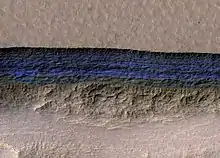Extraterrestrial liquid water
Extraterrestrial liquid water (from Latin extra 'outside of, beyond', and terrestris 'of or belonging to Earth') is water in its liquid state that naturally occurs outside Earth. It is a subject of wide interest because it is recognized as one of the key prerequisites for life as we know it and thus surmised as essential for extraterrestrial life.[1]
Although many celestial bodies in the Solar System have a hydrosphere, Earth is the only celestial body known to have stable bodies of liquid water on its surface, with oceanic water covering 71% of its surface,[2] which is essential to life on Earth. The presence of liquid water is maintained by Earth's atmospheric pressure and stable orbit in the Sun's circumstellar habitable zone, however, the origin of Earth's water remains uncertain.
The main methods currently used for confirmation are absorption spectroscopy and geochemistry. These techniques have proven effective for atmospheric water vapour and ice. However, using current methods of astronomical spectroscopy it is substantially more difficult to detect liquid water on terrestrial planets, especially in the case of subsurface water. Due to this, astronomers, astrobiologists and planetary scientists use habitable zone, gravitational and tidal theory, models of planetary differentiation and radiometry to determine the potential for liquid water. Water observed in volcanic activity can provide more compelling indirect evidence, as can fluvial features and the presence of antifreeze agents, such as salts or ammonia.
Using such methods, many scientists infer that liquid water once covered large areas of Mars and Venus.[3][4] Water is thought to exist as liquid beneath the surface of some planetary bodies, similar to groundwater on Earth. Water vapour is sometimes considered conclusive evidence for the presence of liquid water, although atmospheric water vapour may be found to exist in many places where liquid water does not. Similar indirect evidence, however, supports the existence of liquids below the surface of several moons and dwarf planets elsewhere in the Solar System.[1] Some are speculated to be large extraterrestrial "oceans".[1] Liquid water is thought to be common in other planetary systems, despite the lack of conclusive evidence, and there is a growing list of extrasolar candidates for liquid water. In June 2020, NASA scientists reported that it is likely that exoplanets with oceans may be common in the Milky Way galaxy, based on mathematical modeling studies.[5][6]
Liquid water in the Solar System
As of December 2015, the confirmed liquid water in the Solar System outside Earth is 25–50 times the volume of Earth's water (1.3 billion km3),[7] i.e. about 3.25-6.5 × 1010 km3 (32.5 to 65 billion km3) and 3.25-6.5 × 1019 tons (32.5 to 65 billion tons) of water.
Mars
The Mars ocean hypothesis suggests that nearly a third of the surface of Mars was once covered by water, though the water on Mars is no longer oceanic (much of it residing in the ice caps).
Water on Mars exists today almost exclusively as ice, with a small amount present in the atmosphere as vapour. Some liquid water may occur transiently on the Martian surface today but only under certain conditions.[9] No large standing bodies of liquid water exist because the atmospheric pressure at the surface averages just 600 pascals (0.087 psi)—about 0.6% of Earth's mean sea level pressure—and because the global average temperature is far too low (210 K (−63 °C)), leading to either rapid evaporation or freezing. Features called recurring slope lineae are thought to be caused by flows of brine — hydrated salts.[10][11][12]
In July 2018, scientists from the Italian Space Agency reported the detection of a subglacial lake on Mars, 1.5 kilometres (0.93 mi) below the southern polar ice cap, and spanning 20 kilometres (12 mi) horizontally, the first evidence for a stable body of liquid water on the planet.[13][14] Because the temperature at the base of the polar cap is estimated at 205 K (−68 °C; −91 °F), scientists assume that the water may remain liquid due to the antifreeze effect of magnesium and calcium perchlorates.[13][15] The 1.5-kilometre (0.93 mi) ice layer covering the lake is composed of water ice with 10 to 20% admixed dust, and seasonally covered by a 1-metre (3 ft 3 in)-thick layer of CO2 ice.[13]
Europa
Scientists' consensus is that a layer of liquid water exists beneath the surface of Europa, a moon of Jupiter and that heat from tidal flexing allows the subsurface ocean to remain liquid.[16] It is estimated that the outer crust of solid ice is approximately 10–30 km (6–19 mi) thick, including a ductile "warm ice" layer, which could mean that the liquid ocean underneath may be about 100 km (60 mi) deep.[17] This leads to a volume of Europa's oceans of 3 × 1018 m3 (3 billion km3), slightly more than twice the volume of Earth's oceans.
Enceladus
Enceladus, a moon of Saturn, has shown geysers of water, confirmed by the Cassini spacecraft in 2005 and analyzed more deeply in 2008. Gravimetric data in 2010–2011 confirmed a subsurface ocean. While previously believed to be localized, most likely in a portion of the southern hemisphere, evidence revealed in 2015 now suggests the subsurface ocean is global in nature.[18]
In addition to water, these geysers from vents near the south pole contained small amounts of salt, nitrogen, carbon dioxide, and volatile hydrocarbons. The melting of the ocean water and the geysers appear to be driven by tidal flux from Saturn.
Ganymede
A subsurface saline ocean is theorized to exist on Ganymede, a moon of Jupiter, following observation by the Hubble Space Telescope in 2015. Patterns in auroral belts and rocking of the magnetic field suggest the presence of an ocean. It is estimated to be 100 km deep with the surface lying below a crust of 150 km of ice.[19] As of 2015, the precise quantity of liquid water on Ganymede is highly uncertain (1-33 times as much as Earth).[20]
Ceres
Ceres appears to be differentiated into a rocky core and icy mantle, and may have a remnant internal ocean of liquid water under the layer of ice.[21][22][23] The surface is probably a mixture of water ice and various hydrated minerals such as carbonates and clay. In January 2014, emissions of water vapor were detected from several regions of Ceres.[24] This was unexpected, because large bodies in the asteroid belt do not typically emit vapor, a hallmark of comets. Ceres also features a mountain called Ahuna Mons that is thought to be a cryovolcanic dome that facilitates the movement of high viscosity cryovolcanic magma consisting of water ice softened by its content of salts.[25][26]
Ice giants
The "ice giant" (sometimes known as "water giant") planets Uranus and Neptune are thought to have a supercritical water ocean beneath their clouds, which accounts for about two-thirds of their total mass,[27][28] most likely surrounding small rocky cores, although a 2006 study by Wiktorowicz and Ingersall ruled out the possibility of such a water "ocean" existing on Neptune.[29] This kind of planet is thought to be common in extrasolar planetary systems.
Pluto
In June 2020, astronomers reported evidence that the dwarf planet Pluto may have had a subsurface ocean, and consequently may have been habitable, when it was first formed.[30][31]
Indicators, methods of detection and confirmation
Most known extrasolar planetary systems appear to have very different compositions to the Solar System, though there is probably sample bias arising from the detection methods.
Spectroscopy
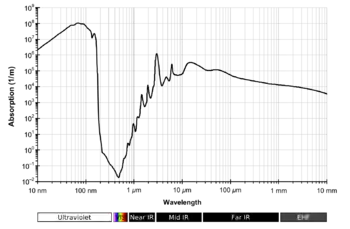

Liquid water has a distinct absorption spectroscopy signature compared to other states of water due to the state of its hydrogen bonds. Despite the confirmation of extraterrestrial water vapor and ice, however, the spectral signature of liquid water is yet to be confirmed outside of Earth. The signatures of surface water on terrestrial planets may be undetectable through thick atmospheres across the vast distances of space using current technology.
Seasonal flows on warm Martian slopes, though strongly suggestive of briny liquid water, have yet to indicate this in spectroscopic analysis.
Water vapor has been confirmed in numerous objects via spectroscopy, though it does not by itself confirm the presence of liquid water. However, when combined with other observations, the possibility might be inferred. For example, the density of GJ 1214 b would suggest that a large fraction of its mass is water and follow-up detection by the Hubble telescope of the presence of water vapor strongly suggests that exotic materials like 'hot ice' or 'superfluid water' may be present.[32][33]
Magnetic fields
For the Jovian moons Ganymede and Europa, the existence of a sub-ice ocean is inferred from the measurements of the magnetic field of Jupiter.[34][35] Since conductors moving through a magnetic field produce a counter-electromotive field, the presence of the water below the surface was deduced from the change in magnetic field as the moon passed from the northern to southern magnetic hemisphere of Jupiter.
Geological indicators
Thomas Gold has posited that many Solar System bodies could potentially hold groundwater below the surface.[36]
It is thought that liquid water may exist in the Martian subsurface. Research suggests that in the past there was liquid water flowing on the surface,[37] creating large areas similar to Earth's oceans. However, the question remains as to where the water has gone.[38] There are a number[39] of direct and indirect proofs of water's presence either on or under the surface, e.g. stream beds, polar caps, spectroscopic measurement, eroded craters or minerals directly connected to the existence of liquid water (such as Goethite). In an article in the Journal of Geophysical Research, scientists studied Lake Vostok in Antarctica and discovered that it may have implications for liquid water still being on Mars. Through their research, scientists came to the conclusion that if Lake Vostok existed before the perennial glaciation began, that it is likely that the lake did not freeze all the way to the bottom. Due to this hypothesis, scientists say that if water had existed before the polar ice caps on Mars, it is likely that there is still liquid water below the ice caps that may even contain evidence of life.[40]
"Chaos terrain", a common feature on Europa's surface, is interpreted by some as regions where the subsurface ocean has melted through the icy crust.
Volcanic observation
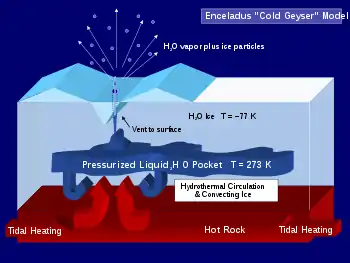
Geysers have been found on Enceladus, a moon of Saturn, and Europa, moon of Jupiter.[41] These contain water vapour and could be indicators of liquid water deeper down.[42] It could also be just ice.[43] In June 2009, evidence was put forward for salty subterranean oceans on Enceladus.[44] On 3 April 2014, NASA reported that evidence for a large underground ocean of liquid water on Enceladus had been found by the Cassini spacecraft. According to the scientists, evidence of an underground ocean suggests that Enceladus is one of the most likely places in the solar system to "host microbial life".[45][46] Emissions of water vapor have been detected from several regions of the dwarf planet Ceres,[47] combined with evidence of ongoing cryovalcanic activity.[48]
Gravitational evidence

Scientists' consensus is that a layer of liquid water exists beneath Europa's surface, and that heat energy from tidal flexing allows the subsurface ocean to remain liquid.[49][50] The first hints of a subsurface ocean came from theoretical considerations of tidal heating (a consequence of Europa's slightly eccentric orbit and orbital resonance with the other Galilean moons).
Scientists used gravitational measurements from the Cassini spacecraft to confirm a water ocean under the crust of Enceladus.[45][46] Such tidal models have been used as theories for water layers in other Solar System moons. According to at least one gravitational study on Cassini data, Dione has an ocean 100 kilometers below the surface.[51]
Anomalies in the orbital libration of Saturn's moon Mimas combined with models of tidal mechanics led scientists in 2022 to propose that it harbours an internal ocean. The finding has surprised many who believed it was not possible for the Solar System's smallest round body, which was previously believed to be frozen solid, and has led to the classification of a new type of "stealth ocean world".[52][53][54]
Ground penetrating radio

Scientists have detected liquid water using radio signals. The radio detection and ranging (RADAR) instrument of the Cassini probe was used to detect the existence of a layer of liquid water and ammonia beneath the surface of Saturn's moon Titan that are consistent with calculations of the moon's density.[55][56] Ground penetrating radar and dielectric permittivity data from the MARSIS instrument on Mars Express indicates a 20-kilometer-wide stable body of briny liquid water in the Planum Australe region of planet Mars.[57]
Density calculation
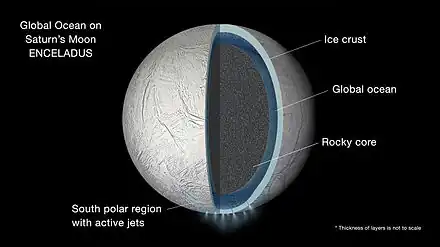
Planetary scientists can use calculations of density to determine the composition of planets and their potential to possess liquid water, though the method is not highly accurate as the combination of many compounds and states can produce similar densities.
Models of Saturn's moon Titan density indicate the presence of a subsurface ocean layer.[56] Similar density estimations are strong indicators of an subsurface ocean on Enceladus.[45][46]
Initial analysis of 55 Cancri e's low density indicated that it consisted 30% supercritical fluid which Diana Valencia of the Massachusetts Institute of Technology proposed could be in the form of salty supercritical water,[58] though follow-up analysis of its transit failed to detect traces of either water or hydrogen.[59]
GJ 1214 b was the second exoplanet (after CoRoT-7b) to have an established mass and radius less than those of the giant Solar System planets. It is three times the size of Earth and about 6.5 times as massive. Its low density indicated that it is likely a mix of rock and water,[60] and follow-up observations using the Hubble telescope now seem to confirm that a large fraction of its mass is water, so it is a large waterworld. The high temperatures and pressures would form exotic materials like 'hot ice' or 'superfluid water'.[32][33]
Models of radioactive decay
Models of heat retention and heating via radioactive decay in smaller icy Solar System bodies suggest that Rhea, Titania, Oberon, Triton, Pluto, Eris, Sedna, and Orcus may have oceans underneath solid icy crusts approximately 100 km thick.[61] Of particular interest in these cases is the fact that the models indicate that the liquid layers are in direct contact with the rocky core, which allows efficient mixing of minerals and salts into the water. This is in contrast with the oceans that may be inside larger icy satellites like Ganymede, Callisto, or Titan, where layers of high-pressure phases of ice are thought to underlie the liquid water layer.[61]
Models of radioactive decay suggest that MOA-2007-BLG-192Lb, a small planet orbiting a small star could be as warm as the Earth and completely covered by a very deep ocean.[62]
Internal differentiation models

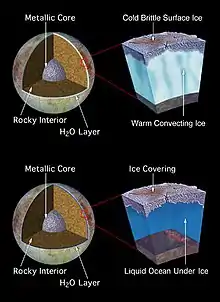
Models of Solar System objects indicate the presence of liquid water in their internal differentiation.
Some models of the dwarf planet Ceres, largest object in the asteroid belt indicate the possibility of a wet interior layer. Water vapor detected to be emitted by the dwarf planet[63][64] may be an indicator, through sublimation of surface ice.
A global layer of liquid water thick enough to decouple the crust from the mantle is thought to be present on Titan, Europa and, with less certainty, Callisto, Ganymede[61] and Triton.[65][66] Other icy moons may also have internal oceans, or have once had internal oceans that have now frozen.[61]
Habitable zone

A planet's orbit in the circumstellar habitable zone is a popular method used to predict its potential for surface water at its surface. Habitable zone theory has put forward several extrasolar candidates for liquid water, though they are highly speculative as a planet's orbit around a star alone does not guarantee that a planet it has liquid water. In addition to its orbit, a planetary mass object must have the potential for sufficient atmospheric pressure to support liquid water and a sufficient supply of hydrogen and oxygen at or near its surface.
The Gliese 581 planetary system contains multiple planets that may be candidates for surface water, including Gliese 581c,[67] Gliese 581d, might be warm enough for oceans if a greenhouse effect was operating,[68] and Gliese 581e.[69]
Gliese 667 C has three of them are in the habitable zone[70] including Gliese 667 Cc is estimated to have surface temperatures similar to Earth and a strong chance of liquid water.[71]
Kepler-22b one of the first 54 candidates found by the Kepler telescope and reported is 2.4 times the size of the Earth, with an estimated temperature of 22 °C. It is described as having the potential for surface water, though its composition is currently unknown.[72]
Among the 1,235 possible extrasolar planet candidates detected by NASA's planet-hunting Kepler space telescope during its first four months of operation, 54 are orbiting in the parent star's habitable 'Goldilocks' zone where liquid water could exist.[73] Five of these are near Earth-size.[74]
On 6 January 2015, NASA announced further observations conducted from May 2009 to April 2013 which included eight candidates between one and two times the size of Earth, orbiting in a habitable zone. Of these eight, six orbit stars that are similar to the Sun in size and temperature. Three of the newly confirmed exoplanets were found to orbit within habitable zones of stars similar to the Sun: two of the three, Kepler-438b and Kepler-442b, are near-Earth-size and likely rocky; the third, Kepler-440b, is a super-Earth.[75]
Water rich circumstellar disks
Long before the discovery of water on asteroids, on comets, and on dwarf planets beyond Neptune, the Solar System's circumstellar disks, beyond the snow line, including the asteroid belt and the Kuiper belt were thought to contain large amounts of water and these were believed to be the Origin of water on Earth. Given that many types of stars are thought to blow volatiles from the system through the photoevaporation effect, water content in circumstellar disks and rocky material in other planetary systems are very good indicators of a planetary system's potential for liquid water and a potential for organic chemistry, especially if detected within the planet forming regions or the habitable zone. Techniques such as interferometry can be used for this.
In 2007, such a disk was found in the habitable zone of MWC 480.[76] In 2008, such a disk was found around the star AA Tauri.[77] In 2009, a similar disk was discovered around the young star HD 142527.[78]
In 2013, a water-rich debris disk around GD 61 accompanied by a confirmed rocky object consisting of magnesium, silicon, iron, and oxygen.[79][80] The same year, another water rich disk was spotted around HD 100546 has ices close to the star.[81]
There is, of course, no guarantee that the other conditions will be found that allow liquid water to be present on a planetary surface. Should planetary mass objects be present, a single, gas giant planet, with or without planetary mass moons, orbiting close to the circumstellar habitable zone, could prevent the necessary conditions from occurring in the system. However, it would mean that planetary mass objects, such as the icy bodies of the solar system, could have abundant quantities of liquid within them.
History
Lunar maria are vast basaltic plains on the Moon that were thought to be bodies of water by early astronomers, who referred to them as "seas". Galileo expressed some doubt about the lunar 'seas' in his Dialogue Concerning the Two Chief World Systems.[lower-alpha 1]
Before space probes were landed, the idea of oceans on Venus was credible science, but the planet was discovered to be much too hot.
Telescopic observations from the time of Galileo onward have shown that Mars has no features resembling watery oceans. Mars' dryness was long recognized, and gave credibility to the spurious Martian canals.
Ancient water on Venus
NASA's Goddard Institute for Space Studies and others have postulated that Venus may have had a shallow ocean in the past for up to 2 billion years,[82][83][84][85][86] with as much water as Earth.[87] Depending on the parameters used in their theoretical model, the last liquid water could have evaporated as recently as 715 million years ago.[84] Currently, the only known water on Venus is in the form of a tiny amount of atmospheric vapor (20 ppm).[88][89] Hydrogen, a component of water, is still being lost to space as detected by ESA's Venus Express spacecraft.[87]
Evidence of past surface water
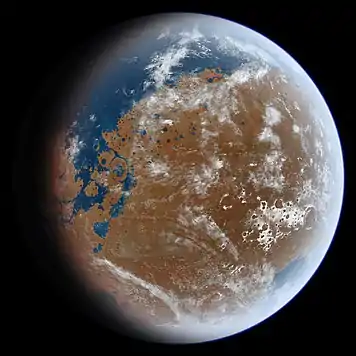
Assuming that the giant-impact hypothesis is correct, there were never real seas or oceans on the Moon, only perhaps a little moisture (liquid or ice) in some places, when the Moon had a thin atmosphere created by degassing of volcanoes or impacts of icy bodies.
The Dawn space probe found possible evidence of past water flow on the asteroid Vesta,[90] leading to speculation of underground reservoirs of water-ice.[91]
Astronomers speculate that Venus had liquid water and perhaps oceans in its very early history.[92] Given that Venus has been completely resurfaced by its own active geology, the idea of a primeval ocean is hard to test. Rock samples may one day give the answer.[93]
It was once thought that Mars might have dried up from something more Earth-like. The initial discovery of a cratered surface made this seem unlikely, but further evidence has changed this view. Liquid water may have existed on the surface of Mars in the distant past, and several basins on Mars have been proposed as dry sea beds.[3] The largest is Vastitas Borealis; others include Hellas Planitia and Argyre Planitia.
There is currently much debate over whether Mars once had an ocean of water in its northern hemisphere, and over what happened to it if it did. Findings by the Mars Exploration Rover mission indicate it had some long-term standing water in at least one location, but its extent is not known. The Opportunity Mars rover photographed bright veins of a mineral leading to conclusive confirmation of deposition by liquid water.[94]
On 9 December 2013, NASA reported that the planet Mars had a large freshwater lake (which could have been a hospitable environment for microbial life) based on evidence from the Curiosity rover studying Aeolis Palus near Mount Sharp in Gale Crater.[95][96]
Liquid water on comets and asteroids
Comets contain large proportions of water ice, but are generally thought to be completely frozen due to their small size and large distance from the Sun. However, studies on dust collected from comet Wild-2 show evidence for liquid water inside the comet at some point in the past.[97] It is yet unclear what source of heat may have caused melting of some of the comet's water ice.
Nevertheless, on 10 December 2014, scientists reported that the composition of water vapor from comet Churyumov–Gerasimenko, as determined by the Rosetta spacecraft, is substantially different from that found on Earth. That is, the ratio of deuterium to hydrogen in the water from the comet was determined to be three times that found for terrestrial water. This makes it very unlikely that water found on Earth came from comets such as comet Churyumov–Gerasimenko according to the scientists.[98][99]
The asteroid 24 Themis was the first found to have water, including liquid pressurised by non-atmospheric means, dissolved into mineral through ionising radiation. Water has also been found to flow on the large asteroid 4 Vesta heated through periodic impacts.[100]
Extrasolar habitable zone candidates for water
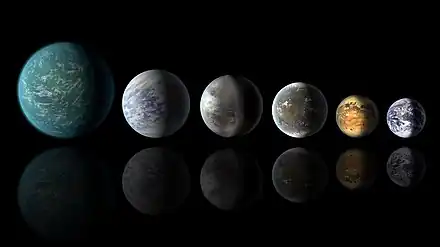
Most known extrasolar planetary systems appear to have very different compositions compared to that of the Solar System, though there may be sample bias arising from the detection methods.
The goal of current searches is to find Earth-sized planets in the habitable zone of their planetary systems (also sometimes called the "Goldilocks zone").[102] Planets with oceans could include Earth-sized moons of giant planets, though it remains speculative whether such 'moons' really exist. There is speculation that rocky planets hosting water may be commonplace throughout the Milky Way.[103]
In July 2022, water was detected on the exoplanet WASP-96b based on spectrum studies with the James Webb Space Telescope.[104] In August 2022, water was detected on the exoplanet TOI-1452 b based on studies with data from the Transiting Exoplanet Survey Satellite (TESS).[105][106]
_(weic2206a).jpeg.webp)
See also
- Planetary oceanography
- Earth analog
- Extraterrestrial oceans
- Water vapor § Extraterrestrial
- List of nearest terrestrial exoplanet candidates
- List of largest lakes and seas in the Solar System
- Ocean world
- Planetary habitability
- Super-Earth
- Terrestrial planet
- Water on terrestrial planets of the Solar System
References
Explanatory notes
- 'Salviati', who normally gives Galileo's own opinions, says:
I say then that if there were in nature only one way for two surfaces to be illuminated by the sun so that one appears lighter than the other, and that this were by having one made of land and the other of water, it would be necessary to say that the moon's surface was partly terrene and partly aqueous. But because there are more ways known to us that could produce the same effect, and perhaps others that we do not know of, I shall not make bold to affirm one rather than another to exist on the moon... What is clearly seen in the moon is that the darker parts are all plains, with few rocks and ridges in them, though there are some. The brighter remainder is all fill of rocks, mountains, round ridges, and other shapes, and in particular there are great ranges of mountains around the spots... I think that the material of the lunar globe is not land and water, and this alone is enough to prevent generations and alterations similar to ours.
Citations
- Dyches, Preston; Chou, Felcia (7 April 2015). "The Solar System and Beyond is Awash in Water". NASA. Retrieved 8 April 2015.
- "Earth". Nineplanets.org. 6 December 2019.
- "Mars Probably Once Had A Huge Ocean". Sciencedaily.com. 13 June 2007. Retrieved 22 January 2012.
- Owen, James (28 November 2007). "Venus Craft Reveals Lightning, Supports Watery Past". National Geographic News. Retrieved 7 September 2016.
- NASA (18 June 2020). "Are planets with oceans common in the galaxy? It's likely, NASA scientists find". EurekAlert!. Retrieved 20 June 2020.
- Shekhtman, Lonnie; et al. (18 June 2020). "Are Planets with Oceans Common in the Galaxy? It's Likely, NASA Scientists Find". NASA. Retrieved 20 June 2020.
- Hall, Shannon (2015). "Our Solar System Is Overflowing with Liquid Water [Graphic]". Scientific American. 314 (6): 14–15. doi:10.1038/scientificamerican0116-14. PMID 27196829.
- Steep Slopes on Mars Reveal Structure of Buried Ice. NASA Press Release. 11 January 2018.
- "NASA Mars Spacecraft Reveals a More Dynamic Red Planet". NASA JPL. 10 December 2013.
- Sample, Ian (28 September 2015). "Nasa scientists find evidence of flowing water on Mars". The Guardian. Retrieved 28 September 2015.
- Wall, Mike (28 September 2015). "Salty Water Flows on Mars Today, Boosting Odds for Life". Space.com. Retrieved 28 September 2015.
- Ojha, Lujendra; Wilhelm, Mary Beth; Murchie, Scott L.; McEwen, Alfred S.; et al. (28 September 2015). "Spectral evidence for hydrated salts in recurring slope lineae on Mars". Nature Geoscience. 8 (11): 829–832. Bibcode:2015NatGe...8..829O. doi:10.1038/ngeo2546.
- Orosei, R.; et al. (25 July 2018). "Radar evidence of subglacial liquid water on Mars". Science. 361 (6401): 490–493. arXiv:2004.04587. Bibcode:2018Sci...361..490O. doi:10.1126/science.aar7268. PMID 30045881.
- Chang, Kenneth; Overbye, Dennis (25 July 2018). "A Watery Lake Is Detected on Mars, Raising the Potential for Alien Life". The New York Times. Retrieved 25 July 2018.
- Halton, Mary (25 July 2018). "Liquid water 'lake' revealed on Mars". BBC News.
- "Tidal Heating". Archived from the original on 29 March 2006.
- Adamu, Zaina (1 October 2012). "Water near surface of a Jupiter moon only temporary". Light Years blog. CNN.
- Wagstaff, Keith (15 September 2015). "Saturn's Moon Enceladus Is Home to a Global Ocean". NBC News. Retrieved 3 October 2015.
- "NASA's Hubble Observations Suggest Underground Ocean on Jupiter's Largest Moon". NASA. 12 March 2015.
- Hall, Shannon (2015). "Our Solar System Is Overflowing with Liquid Water [Graphic]". Scientific American. 314 (6): 14–15. doi:10.1038/scientificamerican0116-14. PMID 27196829.
- McCord, T. B.; Sotin, C. (21 May 2005). "Ceres: Evolution and current state". Journal of Geophysical Research: Planets. 110 (E5): E05009. Bibcode:2005JGRE..110.5009M. doi:10.1029/2004JE002244.
- Redd, Nola Taylor. "Water Ice on Ceres Boosts Hopes for Buried Ocean [Video]". Scientific American. Retrieved 7 April 2016.
- Carey, Bjorn (7 September 2005). "Largest Asteroid Might Contain More Fresh Water than Earth". Space.com. Archived from the original on 18 December 2010. Retrieved 16 August 2006.
- "Water Detected on Dwarf Planet Ceres". NASA Science News. 22 January 2014.
- Skibba, Ramin (1 September 2016). "Giant ice volcano spotted on dwarf planet Ceres". Nature. doi:10.1038/nature.2016.20526. ISSN 0028-0836. S2CID 131884543.
- Ruesch, O.; Platz, T.; Schenk, P.; et al. (2 September 2016). "Cryovolcanism on Ceres". Science. 353 (6303): aaf4286. Bibcode:2016Sci...353.4286R. doi:10.1126/science.aaf4286. PMID 27701087.
- NASA Completes Study of Future 'Ice Giant' Mission Concepts. NASA TV. 20 June 2017.
- NASA, On to the Ice Giants. (PDF) Pre-Decadal study summary, presented at the European Geophysical Union, 24 April 2017.
- Wiktorowicz, Sloane J.; Ingersoll, Andrew P. (2007). "Liquid water oceans in ice giants". Icarus. 186 (2): 436–447. arXiv:astro-ph/0609723. Bibcode:2007Icar..186..436W. doi:10.1016/j.icarus.2006.09.003. ISSN 0019-1035. S2CID 7829260.
- Rabie, Passant (22 June 2020). "New Evidence Suggests Something Strange and Surprising About Pluto". Inverse. Retrieved 23 June 2020.
- Bierson, Carver; et al. (22 June 2020). "Evidence for a hot start and early ocean formation on Pluto". Nature Geoscience. 769 (7): 468–472. Bibcode:2020NatGe..13..468B. doi:10.1038/s41561-020-0595-0. S2CID 219976751. Retrieved 23 June 2020.
- "Distant 'water-world' confirmed". BBC News. 21 February 2012. Retrieved 3 October 2015.
- European Space Agency (ESA) (21 February 2012). "Hubble Reveals a New Class of Extrasolar Planet". ScienceDaily. Retrieved 3 October 2015.
- Fitzpatrick, Garret (12 February 2013). "How Jupiter Moon Europa's Underground Ocean Was Discovered". Space.com.
- "Europa: In Depth". NASA Science.
- Gold, T. (1992). "The deep, hot biosphere". Proceedings of the National Academy of Sciences. 89 (13): 6045–6049. Bibcode:1992PNAS...89.6045G. doi:10.1073/pnas.89.13.6045. ISSN 0027-8424. PMC 49434. PMID 1631089.
- "The Case of the Missing Mars Water". Science@NASA. 5 January 2001. Archived from the original on 27 March 2009. Retrieved 7 March 2009.
- "Water on Mars: Where is it All?". Adler Planetarium. Archived from the original on 10 August 2006. Retrieved 7 March 2009.
- "Water at Martian south pole". ESA. 17 March 2004. Retrieved 29 September 2009.
- Duxbury, N. S.; Zotikov, I. A.; Nealson, K. H.; Romanovsky, V. E.; Carsey, F. D. (2001). "A numerical model for an alternative origin of Lake Vostok and its exobiological implications for Mars". Journal of Geophysical Research. 106 (E1): 1453. Bibcode:2001JGR...106.1453D. doi:10.1029/2000JE001254.
- Cook, Jia-Rui C.; Gutro, Rob; Brown, Dwayne; Harrington, J.D.; Fohn, Joe (12 December 2013). "Hubble Sees Evidence of Water Vapor at Jupiter Moon". NASA. Retrieved 12 December 2013.
- "Cassini Images of Enceladus Suggest Geysers Erupt Liquid Water at the Moon's South Pole". CICLOPS (Cassini Imaging Central Laboratory for OPerationS). 9 March 2006. Archived from the original on 13 March 2012. Retrieved 22 January 2012.
- University of Illinois at Urbana-Champaign (17 August 2007). "Saturn's Moon Enceladus Is Unlikely To Harbor Life". ScienceDaily. Retrieved 22 January 2012.
- Baldwin, Emily (25 June 2009). "Possible salty ocean hidden in depths of Saturn moon". Astronomy Now. Archived from the original on 19 December 2009. Retrieved 22 January 2012.
- Platt, Jane; Bell, Brian (3 April 2014). "NASA Space Assets Detect Ocean inside Saturn Moon". NASA. Retrieved 3 April 2014.
- Iess, L.; Stevenson, D. J.; Parisi, M.; Hemingway, D.; Jacobson, R.A.; Lunine, Jonathan I.; Nimmo, F.; Armstrong, J. W.; Asmar, S. W.; Ducci, M.; Tortora, P. (4 April 2014). "The Gravity Field and Interior Structure of Enceladus" (PDF). Science. 344 (6179): 78–80. Bibcode:2014Sci...344...78I. doi:10.1126/science.1250551. PMID 24700854. S2CID 28990283.}
- NASA Science News: Water Detected on Dwarf Planet Ceres , by Production editor: Tony Phillips | Credit: Science@NASA. 22 January 2014
- Sori, Michael M.; Byrne, Shane; Bland, Michael T.; Bramson, Ali M.; Ermakov, Anton I.; Hamilton, Christopher W.; Otto, Katharina A.; Ruesch, Ottaviano; Russell, Christopher T. (2017). "The vanishing cryovolcanoes of Ceres" (PDF). Geophysical Research Letters. 44 (3): 1243–1250. Bibcode:2017GeoRL..44.1243S. doi:10.1002/2016GL072319. hdl:10150/623032. ISSN 0094-8276. S2CID 52832191.
- "Tidal Heating". geology.asu.edu. Archived from the original on 29 March 2006.
- Greenberg, Richard (2005). Europa: The Ocean Moon: Search for an Alien Biosphere. Springer + Praxis Books. ISBN 978-3-540-27053-9.
- Beuthe, Mikael; Rivoldini, Attilio; Trinh, Antony (2016). "Enceladus's and Dione's floating ice shells supported by minimum stress isostasy". Geophysical Research Letters. 43 (19): 10, 088–10, 096. arXiv:1610.00548. Bibcode:2016GeoRL..4310088B. doi:10.1002/2016GL070650. ISSN 0094-8276. S2CID 119236092.
- Rhoden, Alyssa Rose; Walker, Matthew E. (2022). "The case for an ocean-bearing Mimas from tidal heating analysis". Icarus. Elsevier BV. 376: 114872. Bibcode:2022Icar..37614872R. doi:10.1016/j.icarus.2021.114872. ISSN 0019-1035. S2CID 245718864.
- "SwRI scientist uncovers evidence for an internal ocean in small Saturn moon". Southwest Research Institute (Press release). 19 January 2022. Retrieved 20 January 2022.
- Chang, Kenneth (21 January 2022). "An Ocean May Lurk Inside Saturn's 'Death Star' Moon - New research is converting some skeptics to the idea that tiny, icy Mimas may be full of liquid". The New York Times. Retrieved 22 January 2022.
- Shiga, David (11 June 2007). "Mysterious signal hints at subsurface ocean on Titan". New Scientist. Retrieved 22 January 2012.
- Briggs, Helen (20 March 2008). "Saturn moon may have hidden ocean". BBC News. Retrieved 22 January 2012.
- Orosei, R.; Lauro, S. E.; Pettinelli, E.; et al. (2018). "Radar evidence of subglacial liquid water on Mars". Science. 361 (6401): 490–493. arXiv:2004.04587. Bibcode:2018Sci...361..490O. doi:10.1126/science.aar7268. ISSN 0036-8075. PMID 30045881.
- Grossman, Lisa (18 November 2011). "Astrophile: Supercritical water world does somersaults". New Scientist. Retrieved 22 January 2012.
- Ehrenreich, David; Bourrier, Vincent; Bonfils, Xavier; Lecavelier des Étangs, Alain; Hébrard, Guillaume; Sing, David K.; Wheatley, Peter J.; Vidal-Madjar, Alfred; Delfosse, Xavier; Udry, Stéphane; Forveille, Thierry (1 November 2012). "Hint of a transiting extended atmosphere on 55 Cancri b". Astronomy & Astrophysics. 547: A18. arXiv:1210.0531. Bibcode:2012A&A...547A..18E. doi:10.1051/0004-6361/201219981. ISSN 0004-6361.
- Cooper, Keith (17 December 2009). "The small planet with a thick coat". Astronomy Now. Retrieved 22 January 2012.
- Hussmann, Hauke; Sohl, Frank; Spohn, Tilman (November 2006). "Subsurface oceans and deep interiors of medium-sized outer planet satellites and large trans-neptunian objects". Icarus. 185 (1): 258–273. Bibcode:2006Icar..185..258H. doi:10.1016/j.icarus.2006.06.005.
- University of Notre Dame (3 June 2008). "Small Planet Discovered Orbiting Small Star". ScienceDaily. Retrieved 22 January 2012.
- Küppers, Michael; O'Rourke, Laurence; Bockelée-Morvan, Dominique; Zakharov, Vladimir; Lee, Seungwon; von Allmen, Paul; Carry, Benoît; Teyssier, David; Marston, Anthony; Müller, Thomas; Crovisier, Jacques; Barucci, M. Antonietta; Moreno, Raphael (2014). "Localized sources of water vapour on the dwarf planet (1) Ceres". Nature. 505 (7484): 525–527. Bibcode:2014Natur.505..525K. doi:10.1038/nature12918. ISSN 0028-0836. PMID 24451541. S2CID 4448395.
- Harrington, J.D. (22 January 2014). "Herschel Telescope Detects Water on Dwarf Planet - Release 14-021". NASA. Retrieved 22 January 2014.
- McKinnon, William B.; Kirk, Randolph L. (2007). "Triton". In Lucy Ann Adams McFadden; Lucy-Ann Adams; Paul Robert Weissman; Torrence V. Johnson (eds.). Encyclopedia of the Solar System (2nd ed.). Amsterdam; Boston: Academic Press. pp. 483–502. ISBN 978-0-12-088589-3.
- Javier Ruiz (December 2003). "Heat flow and depth to a possible internal ocean on Triton" (PDF). Icarus. 166 (2): 436–439. Bibcode:2003Icar..166..436R. doi:10.1016/j.icarus.2003.09.009. Archived from the original (PDF) on 12 December 2019. Retrieved 5 January 2019.
- Than, Ker (24 April 2007). "New Planet Could Harbor Water and Life". Space.com. Retrieved 22 January 2012.
- Than, Ker (18 June 2007). "Scientists might have picked right star, wrong world for hosting life". NBC News. Retrieved 22 January 2012.
- "Exoplanet near Gliese 581 star 'could host life'". BBC News. 17 May 2011. Retrieved 22 January 2012.
- European Southern Observatory (ESO) (25 June 2013). "Three Planets in Habitable Zone of Nearby Star: Gliese 667c Reexamined". ScienceDaily. Retrieved 3 October 2015.
- Baldwin, Emily (2 February 2012). "Super-Earth orbits in habitable zone of cool star". Astronomy Now. Retrieved 3 October 2015.
- "Kepler 22-b: Earth-like planet confirmed". BBC News. 5 December 2011. Retrieved 22 January 2012.
- Harwood, William (2 February 2011). "Kepler detects more than 1,200 possible planets". Spaceflight Now. Retrieved 22 January 2012.
- Lissauer, Jack J.; Fabrycky, Daniel C.; Ford, Eric B.; et al. (2 February 2011). "NASA Finds Earth-Size Planet Candidates in Habitable Zone, Six Planet System". Nature. 470 (7332): 53–8. arXiv:1102.0291. Bibcode:2011Natur.470...53L. doi:10.1038/nature09760. PMID 21293371. S2CID 4388001. Retrieved 22 January 2012.
- Clavin, Whitney; Chou, Felicia; Johnson, Michele (6 January 2015). "NASA's Kepler Marks 1,000th Exoplanet Discovery, Uncovers More Small Worlds in Habitable Zones". NASA. Retrieved 6 January 2015.
- Eisner, J. A. (2007). "Water vapour and hydrogen in the terrestrial-planet-forming region of a protoplanetary disk". Nature. 447 (7144): 562–564. arXiv:0706.1239. Bibcode:2007Natur.447..562E. doi:10.1038/nature05867. ISSN 0028-0836. PMID 17538613. S2CID 4362195.
- Carr, J. S.; Najita, J. R. (2008). "Organic Molecules and Water in the Planet Formation Region of Young Circumstellar Disks". Science. 319 (5869): 1504–1506. Bibcode:2008Sci...319.1504C. doi:10.1126/science.1153807. ISSN 0036-8075. PMID 18339932. S2CID 1125520.
- Honda, M.; Inoue, A. K.; Fukagawa, M.; et al. (2009). "Detection of Water Ice Grains on the Surface of the Circumstellar Disk Around Hd 142527". The Astrophysical Journal. 690 (2): L110–L113. Bibcode:2009ApJ...690L.110H. doi:10.1088/0004-637X/690/2/L110. ISSN 0004-637X.
- University of Cambridge (10 October 2013). "Watery asteroid discovered in dying star points to habitable exoplanets". Phys.org. Retrieved 12 October 2013.
- Mack, Eric (17 October 2011). "Newly spotted wet asteroids point to far-flung Earth-like planets | Crave – CNET". News.cnet.com. Retrieved 12 October 2013.
- Honda, M.; Kudo, T.; Takatsuki, S.; et al. (2016). "Water Ice at the Surface of the Hd 100546 Disk". The Astrophysical Journal. 821 (1): 2. arXiv:1603.09512. Bibcode:2016ApJ...821....2H. doi:10.3847/0004-637X/821/1/2. ISSN 1538-4357. S2CID 119275458.
- Hashimoto, G. L.; Roos-Serote, M.; Sugita, S.; et al. (2008). "Felsic highland crust on Venus suggested by Galileo Near-Infrared Mapping Spectrometer data". Journal of Geophysical Research: Planets. 113 (E9): E00B24. Bibcode:2008JGRE..113.0B24H. doi:10.1029/2008JE003134.
- Shiga, David (10 October 2007). "Did Venus's ancient oceans incubate life?". New Scientist.
- Way, Michael J.; et al. (26 August 2016). "Was Venus the First Habitable World of our Solar System?". Geophysical Research Letters. 43 (16): 8376–8383. arXiv:1608.00706. Bibcode:2016GeoRL..43.8376W. doi:10.1002/2016GL069790. PMC 5385710. PMID 28408771.
- Cabbage, Michael; McCarthy, Leslie (11 August 2016). "NASA climate modeling suggests Venus may have been habitable". NASA. Retrieved 19 November 2016.
- Hall, Shannon (10 August 2016). "Hellish Venus Might Have Been Habitable for Billions of Years". Scientific American. Retrieved 19 November 2016.
- "Where did Venus's water go?". European Space Agency. 18 December 2008. Retrieved 19 November 2016.
- Basilevsky, Alexandr T.; Head, James W. (2003). "The surface of Venus". Rep. Prog. Phys. 66 (10): 1699–1734. Bibcode:2003RPPh...66.1699B. doi:10.1088/0034-4885/66/10/R04. S2CID 250815558.
- Bertaux, Jean-Loup; Vandaele, Ann-Carine; Korablev, Oleg; et al. (2007). "A warm layer in Venus' cryosphere and high-altitude measurements of HF, HCl, H2O and HDO" (PDF). Nature. 450 (7170): 646–649. Bibcode:2007Natur.450..646B. doi:10.1038/nature05974. PMID 18046397. S2CID 4421875.
- Amos, Jonathan (6 December 2012). "Dawn probe spies possible water-cut gullies on Vesta". BBC News. Retrieved 3 October 2015.
- "Huge Asteroid Vesta May Be Packed With Water Ice". Space.com. 26 January 2012. Retrieved 3 October 2015.
- Owen, James (28 November 2007). "Venus Craft Reveals Lightning, Supports Watery Past". National Geographic News. Archived from the original on 30 November 2007.
- "Did oceans on Venus harbour life?". New Scientist. 196 (2626): 22. 2007. doi:10.1016/S0262-4079(07)62635-9. ISSN 0262-4079.
- Webster, Guy (7 December 2011). "NASA Mars Rover Finds Mineral Vein Deposited by Water". NASA JPL. Retrieved 22 January 2012.
- Chang, Kenneth (9 December 2013). "On Mars, an Ancient Lake and Perhaps Life". The New York Times. Retrieved 9 December 2013.
- "Curiosity Mars". Science (Search results). 9 December 2013. Retrieved 9 December 2013.
- Berger, Eve L.; Zega, Thomas J.; Keller, Lindsay P.; Lauretta, Dante S. (5 April 2011). "Frozen comet's watery past: Discovery challenges paradigm of comets as 'dirty snowballs' frozen in time". Geochimica et Cosmochimica Acta. 75 (12): 3501. Bibcode:2011GeCoA..75.3501B. doi:10.1016/j.gca.2011.03.026. Retrieved 22 January 2012.
- Agle, DC; Bauer, Markus (10 December 2014). "Rosetta Instrument Reignites Debate on Earth's Oceans". NASA. Retrieved 10 December 2014.
- Chang, Kenneth (10 December 2014). "Comet Data Clears Up Debate on Earth's Water". The New York Times. Retrieved 10 December 2014.
- De Sanctis, M. C.; Combe, J.-Ph.; Ammannito, E.; et al. (2012). "Detection of Widespread Hydrated Materials on Vesta by the VIR Imaging Spectrometer on Board the Dawn Mission". The Astrophysical Journal. 758 (2): L36. Bibcode:2012ApJ...758L..36D. doi:10.1088/2041-8205/758/2/L36. ISSN 2041-8205.
- "Water-worlds are common: Exoplanets may contain vast amounts of water". Phys.org. 17 August 2018. Retrieved 17 August 2018.
- Garlick, Mark A. (3 January 2003). "Habitable planets may be common". New Scientist. Retrieved 22 January 2012.
- Baldwin, Emily (13 April 2011). "Water, water everywhere". Astronomy Now. Archived from the original on 22 July 2011. Retrieved 22 January 2012.
- Cesari, Thaddeus (11 July 2022). "NASA Shares List of Cosmic Targets for Webb Telescope's First Images". NASA. Archived from the original on 12 July 2022. Retrieved 19 September 2022.
- DePresse, Salle (24 August 2022). "An extrasolar world covered in water?". Université de Montréal. Retrieved 19 September 2022.
- Brennan, Pat (24 August 2022). "Discovery Alert: Intriguing New 'Super-Earth' Could Get a Closer Look". NASA. Retrieved 19 September 2022.
External links
- The Extrasolar Planets Encyclopaedia
- Astronomy & Astrophysics (14 December 2007). "Gliese 581: Extrasolar Planet Might Indeed Be Habitable". ScienceDaily.
- University of Texas at Austin (14 December 2007). "Jupiter's Moon Europa: What Could Be Under The Ice?". ScienceDaily.
- University of Florida (24 December 2007). "To Curious Aliens, Earth Would Stand Out As Living Planet". ScienceDaily.
- Ohio State University (16 December 2008). "Ocean-bearing Planets: Looking For Extraterrestrial Life In All The Right Places". ScienceDaily.
